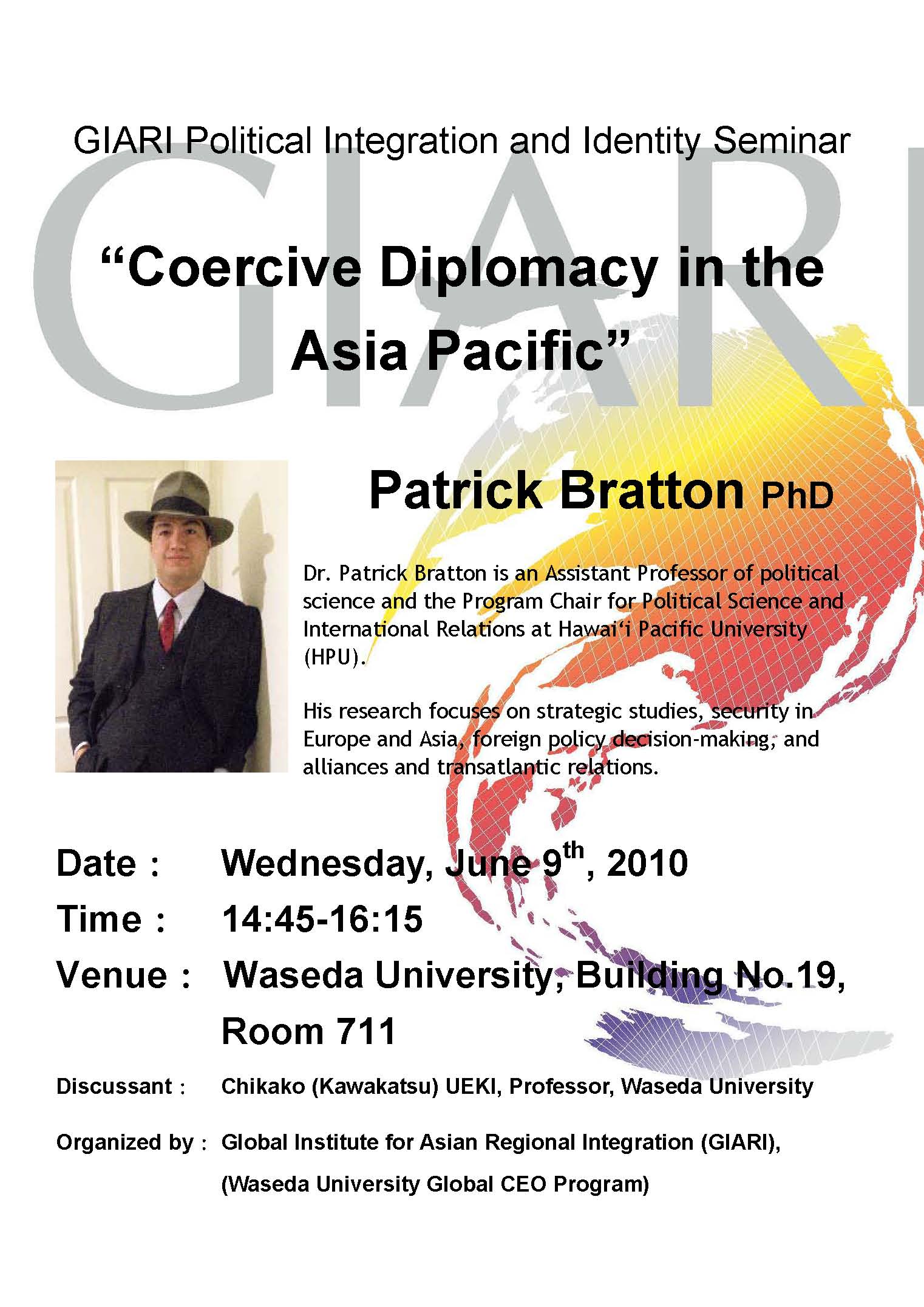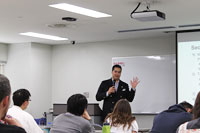Political Integration and Identity
Research:Seminars/Workshops
GIARI Political Integration and Identity Seminar "Coercive Diplomacy in the Asia Pacific"
2010.06.09
Coercive Diplomacy in the Asia Pacific
- Title: "Coercive Diplomacy in the Asia Pacific"
- Lecturer: Dr. Patrick Bratton, Assistant Professor at Hawaii Pacific University (HPU)
- Date: June 9 (Wed.), 2010
- Time: 14:45−16:15
- Venue: Room 711, Building 19, Waseda University
- Language: English (No-translation)
- Admission Free, No-preregistration
- Discussant: Dr. Chikako (KAWAKATSU) UEKI, Professor at Waseda University
- Organized by GIARI: Global Institute for Asian Regional Integration(Waseda University Global COE Program)
 summary[101KB]
summary[101KB]
Presentation: “Coercive Diplomacy in the Asia Pacific”
Coercion seems straightforward in a theory because a target is supposed to give in if the threat of non-compliance outweighs the costs of compliance. However, the reality is much more complicated than the theory. There are three overlooked factors that inhibit effectiveness of coercion: coding problems, non-unitary rational actors, and short-terms success. There are also factors that facilitate success of coercion, but most factors are contextual. Therefore, coercion is very difficult in practice.
There are different forms of coercion: deterrence and compellence. While deterrence is a threat to induce inaction, compellence is a threat to induce action. There is also a difference between coercion and brute force. The former leaves a target a choice for settlement, but the latter no choice. In brute force an actor takes what it wants by violence.
Coercive diplomacy can be implemented by a variety of tools. Generally speaking, at the bottom end of the spectrum are diplomatic sanctions: canceling state visits, cultural or educational exchange programs, revising diplomatic positions on sensitive issues. Next up the ladder are economic sanctions which can be limited to certain types of products, can be unilateral or the coercer can use allies or international organizations to apply multilateral sanctions. Lastly is military force. However, military force can be used in coercive diplomacy without the actual use of violence.
Coercion depends on two factors: credibility (whether the target believes that the coercer will execute its threats) and persuasiveness (whether the threats will have a great impact on the target). Threats are not automatically both credible and persuasive; they can also be one but not the other. In fact, the two are often inversely related; threats that are credible are not often persuasive, and those that are persuasive are not very credible. For example, in the context of a trade dispute a threat of nuclear attack would be very persuasive but not very credible.
The key to build up credibility and persuasiveness is for the coercer to send clear signals that convey both the demands that the target has to do and the threats of punishment of what will happen if the target does not comply. These signals can be both verbal and non-verbal, in particular non-verbal signals like the implementation of economic sanctions, or the deployment of military forces, are seen as costly signals.
One of the great puzzles facing an analyst of coercion is that while coercion seems straightforward in theory, it is very difficult in practice. Three factors inhibit effectiveness of coercion: coding problems, non-unitary rational actors, and short-term nature of success.
First, there is a problem with accurately coding successes and failures. It is extremely difficult to judge whether coercion succeeded or failed when the target gives in to only some parts, but not all of the coercer’s demands. Second, it is misleading to code cases of coercion in only “success” and “failure” as the only possible outcomes. Third, the data set of cases may be actually fundamentally flawed. Perhaps we believe coercion is difficult because we only look at cases where it has failed. Many scholars have suggested that by privileging cases where the sanctions have actually been used draws us to the hardest cases, where they are least likely to work.
Second, coercion writers have for the most part assumed that states involved in coercion are unitary, rational actors. It has been subsequently pointed out that the rational actor model forgets that the coercer and the target of the coercion are actually governments rather than individuals: Governments are coalitions of numerous individual decision-makers, virtually all of whom occupy positions within large, semiautonomous, bureaucratic organizations; any government involved in an attempt at coercion is likely to speak with many voices at once. These individuals within a target government react differently to coercive measures. This suggests that even if a coercer succeeded in getting demands accepted in the short term, it would be very difficult to secure complete acquiescence in the long term, because certain members of the target's government would attempt to reinstate their objectionable policies, since their political careers (and in some regimes, their lives) depend on it. Likewise, a coercer is not a unitary, rational actor, and therefore it has difficulties in sending clear and coherent messages and orchestrating them.
Third, coercion tends to be short-lived. If vital interests are not on the part of the target, coercion is highly likely to fail in the long run. Therefore, a coercer needs to anchor coercive diplomacy to make settlement with the target for long-term success. It must be remembered that coercion is not a substitute for an effective foreign policy. A comprehensive study has been made of American political uses of military forces, including coercive threats and deployments in support of allies, between 1946 and 1975. It found that most of the time these actions served only to buy time and that the effectiveness declined sharply over time. It should be recognized that coercive military operations cannot substitute for more fundamental policies and actions—diplomacy, close economic and cultural relations, an affinity of mutual interests and perceptions—which can form the basis either for sound and successful alliances or for stable adversary relations. If coercion can produce only a breathing space, the coercer needs to consider using that time to reduce the motivation underlying that aggressive intention, and/or to provide alternative goals that may be relatively satisfactory to the deterred power.
Due to these reasons, coercive diplomacy failed in many cases. For coercive diplomacy in the Cold War the US by most academic accounts had only one case of success: the Cuban Missile Crisis. This was facilitated by several important factors that tended to make coercion more likely and to make its success last longer.
First, the most important and obvious one is that the goals of the coercer and the target need to be non-exclusive. The coercer cannot make demands that are completely antithetical to the primary interests of the target. If the coercer does, any success purely through the use of threats is likely to fail, and even if they are successful they are bound to be short lived.
Second, both parties need willingness to settle for a sub-optimal compromise. This need for a compromise between the two is often overlooked in conventional understandings of coercion. It must be remembered that the coercer is attempting to get what it wants without having to endure the costs of a full-scale war, so it cannot reasonably expect to get all the benefits of war: for example, taking all that it wants by force. So by definition success through coercion depends upon compromise.
Third, the compromise needs to address in some fashion the interests that caused the behavior. It is important to consider that the target had reasons for doing what made the coercer angry in the first place. Therefore unless those reasons are addressed, at least in some way, then after the immediate threat is gone those actions will likely start again. It is unlikely the coercer can simply maintain its success unless it is comfortable paying high enforcement costs repeatedly in the years that follow.
Fourth, monitoring and enforcement of the agreement is another important factor for success of coercion. Once a settlement is reached between the coercer and the target, the question is whether the target will abide by the settlement or not. While the reached agreement ideally should prevent this from happening, having a method of monitoring and enforcing the settlement without resorting to coercion or war again is useful. An effective monitoring and enforcing regime must be both within the coercer’s power and also built into the settlement.
It is noted that most of these factors that facilitate success are contextual, they are set before the coercive contest begins and are unchangeable; commitment and credibility are hard to build during crisis; their goals and interests should be nonexclusive, but these are set before the crisis start; monitoring and enforcement regimes are facilitated by geography and military/intelligence capabilities, which are unchangeable with limited time. In other words, there are significant limitations in what policymakers can do to make coercion successful. As a result, coercion turns out to be very difficult to work in reality.
There are different forms of coercion: deterrence and compellence. While deterrence is a threat to induce inaction, compellence is a threat to induce action. There is also a difference between coercion and brute force. The former leaves a target a choice for settlement, but the latter no choice. In brute force an actor takes what it wants by violence.
Coercive diplomacy can be implemented by a variety of tools. Generally speaking, at the bottom end of the spectrum are diplomatic sanctions: canceling state visits, cultural or educational exchange programs, revising diplomatic positions on sensitive issues. Next up the ladder are economic sanctions which can be limited to certain types of products, can be unilateral or the coercer can use allies or international organizations to apply multilateral sanctions. Lastly is military force. However, military force can be used in coercive diplomacy without the actual use of violence.
Coercion depends on two factors: credibility (whether the target believes that the coercer will execute its threats) and persuasiveness (whether the threats will have a great impact on the target). Threats are not automatically both credible and persuasive; they can also be one but not the other. In fact, the two are often inversely related; threats that are credible are not often persuasive, and those that are persuasive are not very credible. For example, in the context of a trade dispute a threat of nuclear attack would be very persuasive but not very credible.
The key to build up credibility and persuasiveness is for the coercer to send clear signals that convey both the demands that the target has to do and the threats of punishment of what will happen if the target does not comply. These signals can be both verbal and non-verbal, in particular non-verbal signals like the implementation of economic sanctions, or the deployment of military forces, are seen as costly signals.
One of the great puzzles facing an analyst of coercion is that while coercion seems straightforward in theory, it is very difficult in practice. Three factors inhibit effectiveness of coercion: coding problems, non-unitary rational actors, and short-term nature of success.
First, there is a problem with accurately coding successes and failures. It is extremely difficult to judge whether coercion succeeded or failed when the target gives in to only some parts, but not all of the coercer’s demands. Second, it is misleading to code cases of coercion in only “success” and “failure” as the only possible outcomes. Third, the data set of cases may be actually fundamentally flawed. Perhaps we believe coercion is difficult because we only look at cases where it has failed. Many scholars have suggested that by privileging cases where the sanctions have actually been used draws us to the hardest cases, where they are least likely to work.
Second, coercion writers have for the most part assumed that states involved in coercion are unitary, rational actors. It has been subsequently pointed out that the rational actor model forgets that the coercer and the target of the coercion are actually governments rather than individuals: Governments are coalitions of numerous individual decision-makers, virtually all of whom occupy positions within large, semiautonomous, bureaucratic organizations; any government involved in an attempt at coercion is likely to speak with many voices at once. These individuals within a target government react differently to coercive measures. This suggests that even if a coercer succeeded in getting demands accepted in the short term, it would be very difficult to secure complete acquiescence in the long term, because certain members of the target's government would attempt to reinstate their objectionable policies, since their political careers (and in some regimes, their lives) depend on it. Likewise, a coercer is not a unitary, rational actor, and therefore it has difficulties in sending clear and coherent messages and orchestrating them.
Third, coercion tends to be short-lived. If vital interests are not on the part of the target, coercion is highly likely to fail in the long run. Therefore, a coercer needs to anchor coercive diplomacy to make settlement with the target for long-term success. It must be remembered that coercion is not a substitute for an effective foreign policy. A comprehensive study has been made of American political uses of military forces, including coercive threats and deployments in support of allies, between 1946 and 1975. It found that most of the time these actions served only to buy time and that the effectiveness declined sharply over time. It should be recognized that coercive military operations cannot substitute for more fundamental policies and actions—diplomacy, close economic and cultural relations, an affinity of mutual interests and perceptions—which can form the basis either for sound and successful alliances or for stable adversary relations. If coercion can produce only a breathing space, the coercer needs to consider using that time to reduce the motivation underlying that aggressive intention, and/or to provide alternative goals that may be relatively satisfactory to the deterred power.
Due to these reasons, coercive diplomacy failed in many cases. For coercive diplomacy in the Cold War the US by most academic accounts had only one case of success: the Cuban Missile Crisis. This was facilitated by several important factors that tended to make coercion more likely and to make its success last longer.
First, the most important and obvious one is that the goals of the coercer and the target need to be non-exclusive. The coercer cannot make demands that are completely antithetical to the primary interests of the target. If the coercer does, any success purely through the use of threats is likely to fail, and even if they are successful they are bound to be short lived.
Second, both parties need willingness to settle for a sub-optimal compromise. This need for a compromise between the two is often overlooked in conventional understandings of coercion. It must be remembered that the coercer is attempting to get what it wants without having to endure the costs of a full-scale war, so it cannot reasonably expect to get all the benefits of war: for example, taking all that it wants by force. So by definition success through coercion depends upon compromise.
Third, the compromise needs to address in some fashion the interests that caused the behavior. It is important to consider that the target had reasons for doing what made the coercer angry in the first place. Therefore unless those reasons are addressed, at least in some way, then after the immediate threat is gone those actions will likely start again. It is unlikely the coercer can simply maintain its success unless it is comfortable paying high enforcement costs repeatedly in the years that follow.
Fourth, monitoring and enforcement of the agreement is another important factor for success of coercion. Once a settlement is reached between the coercer and the target, the question is whether the target will abide by the settlement or not. While the reached agreement ideally should prevent this from happening, having a method of monitoring and enforcing the settlement without resorting to coercion or war again is useful. An effective monitoring and enforcing regime must be both within the coercer’s power and also built into the settlement.
It is noted that most of these factors that facilitate success are contextual, they are set before the coercive contest begins and are unchangeable; commitment and credibility are hard to build during crisis; their goals and interests should be nonexclusive, but these are set before the crisis start; monitoring and enforcement regimes are facilitated by geography and military/intelligence capabilities, which are unchangeable with limited time. In other words, there are significant limitations in what policymakers can do to make coercion successful. As a result, coercion turns out to be very difficult to work in reality.
Photos





